

Biology and Life Science Video Animations.
Teaching Genetic Linkage and Recombination through Mapping with Molecular Markers. Genetic linkage and recombination are core concepts in an undergraduate genetics curriculum(1), but many educators find the traditional method of teaching this topic is problematic.
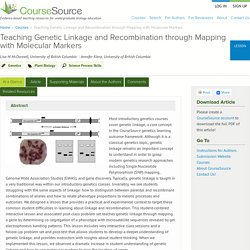
Despite the common challenges encountered when teaching genetic linkage, we were surprisingly unable to find published information providing teaching strategies or tips to improve student understanding of genetic linkage and recombination. Typically, students analyze crosses involving somewhat random phenotypes, such as 'Waltzing' or 'bent-tail' mice(2), and even after instruction and practice, they are rarely able to articulate the utility of understanding or using genetic linkage. Through the observation of students solving genetic linkage problems, we noted that most simply memorize a strategy or formula to solve genetics linkage problems. Microsatellites are tandem repeats of two to six base pairs. Intended Audience Learning time Pre-requisite student knowledge S1a.
Frequently Asked Questions. High School Bioethics Curriculum Project*(HSBCP) FAQ: Teaching Bioethics in the High School Classroom Q.
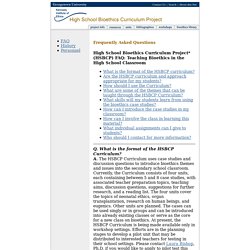
What is the format of the HSBCP Curriculum? A. The HSBCP Curriculum uses case studies and discussion questions to introduce bioethics themes and issues into the secondary school classroom. Currently, the Curriculum consists of four units, each containing between 5 and 8 case studies, with associated teacher preparation topics, teaching aims, discussion questions, suggestions for further research, and a reading list. Q. A. Sciences, Social sciences, And the humanities. The HSBCP's Curriculum may be and has been used in: Teacher Toolbox.
Home » Teacher Toolbox This page contains documents and links I used in teacher workshops I conducted as part of the NSF GK-12 Program at the Environmental Science Institute at the University of Texas at Austin, or referred to in training sessions I currently conduct for the National Math and Science Initiative.
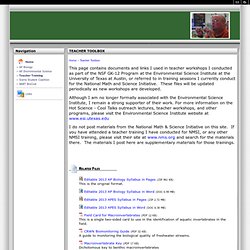
These files will be updated periodically as new workshops are developed. Although I am no longer formally associated with the Environmental Science Institute, I remain a strong supporter of their work. For more information on the Hot Science - Cool Talks outreach lectures, teacher workshops, and other programs, please visit the Environmental Science Institute website at www.esi.utexas.edu I do not post materials from the National Math & Science Initiative on this site.
Editable 2013 AP Biology Syllabus in Pages (ZIP 961 KB)This is the original format. Editable 2013 AP Biology Syllabus in Word (DOC 0.99 MB) Editable 2013 APES Syllabus in Pages (ZIP 2.72 MB) What Is a Nanometer?
The Molecular Clock and Estimating Species Divergence. A recent study by Weir and Schluter (2008) demonstrates the use of different calibration techniques.
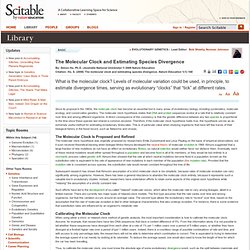
To estimate the evolutionary rate of the mitochondrial gene encoding cytochrome b in birds, Weir and Schluter chose 90 different calibrations derived from dated fossils and from the formation ages of land bridges, oceanic islands, and mountain ranges. They then used a statistical method to check each of these calibrations and discarded 16 that were found to be inconsistent. Using the remaining 74 calibrations, the duo estimated that cytochrome b genes in birds evolve at an average rate of approximately 1% per 1 million years, meaning that any two bird species are diverging from each other at a rate of 2% per 1 million years.
This has long been regarded as a standard quantity in genetic studies of birds and is known as the "2% rule. " Weir and Schluter also noted that the rate of molecular evolution varies significantly among different bird species. 2A: PHOTOSYNTHESIS, CELLULAR RESPIRATION, AND ENERGY - MAEDA HS AP BIOLOGY REVIEW MARATHON. Biology 101: Intro to Biology Course - Free Online Video Lessons. The Biology Project. Biology Teaching Resources. Welcome to the Teachers' Center at Explore Biology.
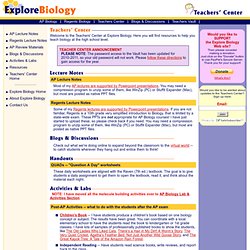
Here you will find resources to help you teach biology at the high school level. Some of my Regents lectures are supported by Powerpoint presentations. If you are not familiar, Regents is a 10th grade very simplified introduction to Biology, that is limited by a state-wide exam. These PPTs are not appropriate for AP Biology courses!
I have just started to upload these, so please check back if you need. Check out what we're doing online to expand beyond the classroom to the virtual world -- to catch students wherever they hang out and entice them to think! These daily worksheets are aligned with the Raven (7th ed.) textbook. NOTE: I have moved all the molecule building activities over to AP Biology Lab & Activities Section Post-AP Activities -- what to do with the students after the AP exam Children's Book -- I have students produce a children's book based on one biology concept or subject. Summer Assignments Summer Assignment 2010.
Online Onion Root Tips.
Project Neuron. Molecular Biology. College Biomes of the World. Learn Science at Nature.